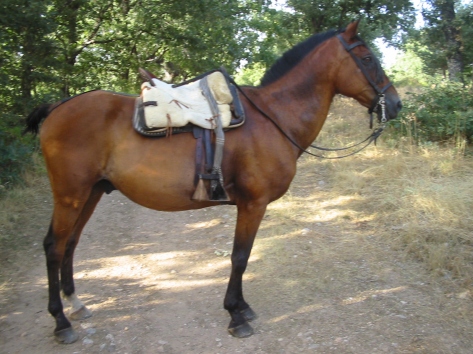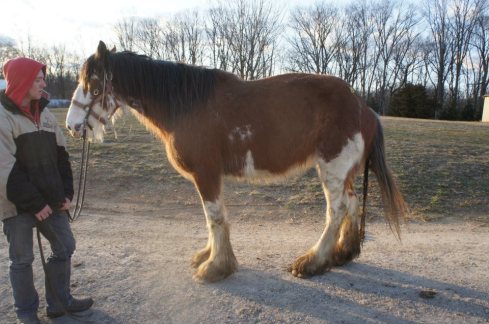Last week’s post touched the tip of the iceberg when it comes to funky horse designs. Generations of human interference, often breeding for specific traits (i.e. pretty colour), have resulted in some less pleasant/useable/sane traits slipping through into new generations. That being said, horses themselves aren’t terribly fussy when it comes to picking partners, so wild horses can also be a bit funny-looking, although survival of the fittest at least makes sure that they have decent feet and teeth.
Worse than this, however, are equine traits that are entirely caused by how the horse is ridden.
Some truly scary defects can arise in horses, caused purely by how badly the horse is handled by people.
First up, ewe necks.
 A eye neck is typically caused by bad riding or incorrect training, resulting in over-development of the muscles around the throat and underside of the neck and collapse of the topline. In worst-case scenarios, these horses have issues with grazing or eating from the ground. Funny thing is, ewe necks are easily fixed with good training, stretching and physiotherapy.
A eye neck is typically caused by bad riding or incorrect training, resulting in over-development of the muscles around the throat and underside of the neck and collapse of the topline. In worst-case scenarios, these horses have issues with grazing or eating from the ground. Funny thing is, ewe necks are easily fixed with good training, stretching and physiotherapy.
Next, swan necks.
 Very similar to a ewe neck, but the horse angles their face downwards and therefore is often mistaken by inexperienced riders/trainers for travelling on the bit in a correct frame. If you you look at the spine, particularly at the unnatural “dip” before the withers, as well as the over-muscled underside of the neck, interruption in the muscular development is clear. Another hint in this photograph is the fact that the horse is not tracking up (i.e. there is a big gap between where his front right and back right feet are landing), which is a symptom of poor back training. Once again, these is easily amended by proper, careful riding and stretching.
Very similar to a ewe neck, but the horse angles their face downwards and therefore is often mistaken by inexperienced riders/trainers for travelling on the bit in a correct frame. If you you look at the spine, particularly at the unnatural “dip” before the withers, as well as the over-muscled underside of the neck, interruption in the muscular development is clear. Another hint in this photograph is the fact that the horse is not tracking up (i.e. there is a big gap between where his front right and back right feet are landing), which is a symptom of poor back training. Once again, these is easily amended by proper, careful riding and stretching.
Next up, a swayed back.
 These can range from mild to very severe and are usually caused by riding a horse much too early in life, and exacerbated by not building up the horse’s back muscles to compensate for the rider’s weight. Can also be created by pregnancies and as a normal part of the aging process, but more often than not come down to bad timing and training if you see this in a young horse.
These can range from mild to very severe and are usually caused by riding a horse much too early in life, and exacerbated by not building up the horse’s back muscles to compensate for the rider’s weight. Can also be created by pregnancies and as a normal part of the aging process, but more often than not come down to bad timing and training if you see this in a young horse.
And finally, a roached back. The opposite (more or less) to a swayed back, but slightly more complex.
These are usually genetic, or exacerbated by rapid and abnormal growth when the horse is a weanling, but can also be caused by badly-fitted saddles or spinal trauma, resulting in loss of flexibility to the horse’s vertebrae. This isn’t a condition that can be alleviated – once it’s here, it’s here to stay. However, specialist saddle fitting and stretching techniques can help with stiffness and some horses can have very good showing careers even with this issue.
In brief, stretching exercises are your friends. They make healthier, happier horses, with far fewer human-induced defects. I will go through some of these next week!

these are all so sad I feel so bad